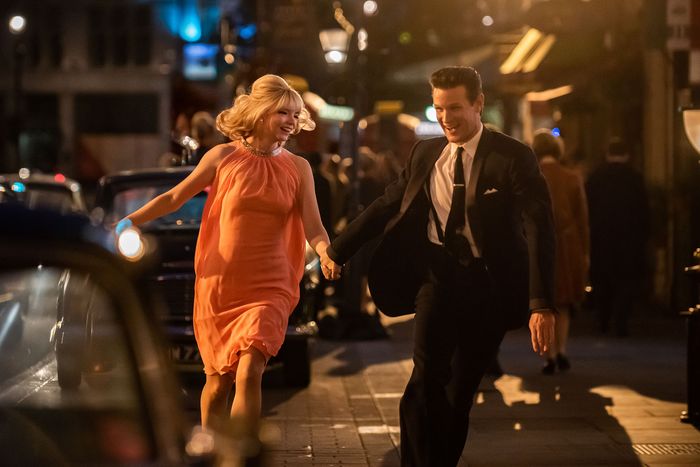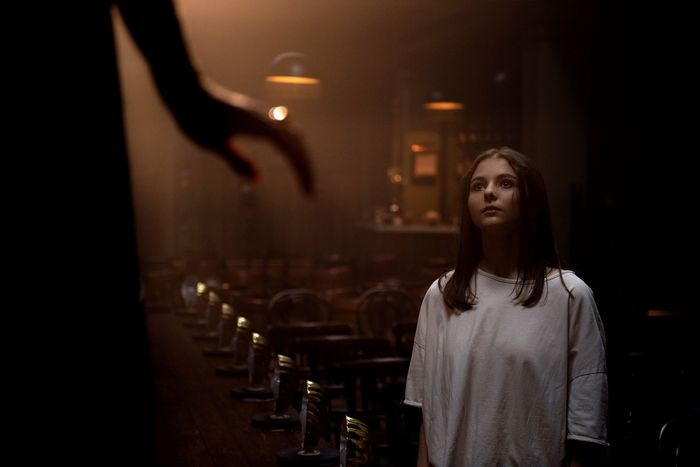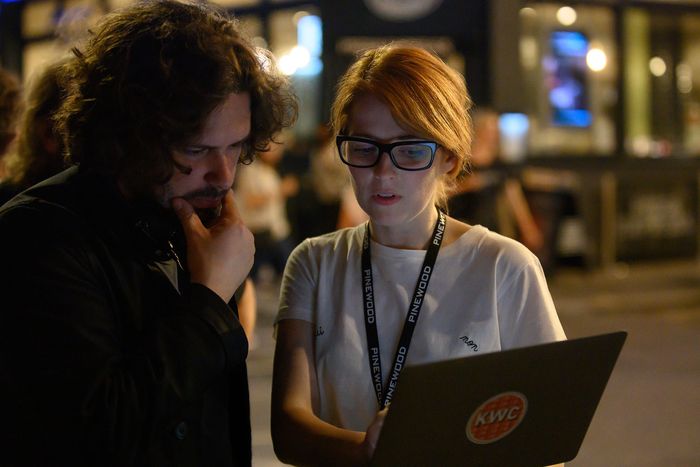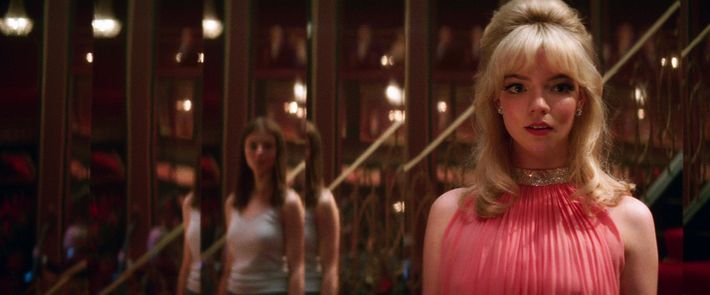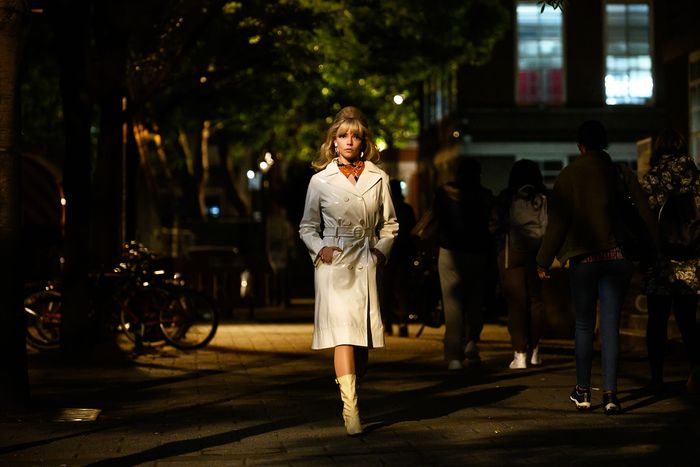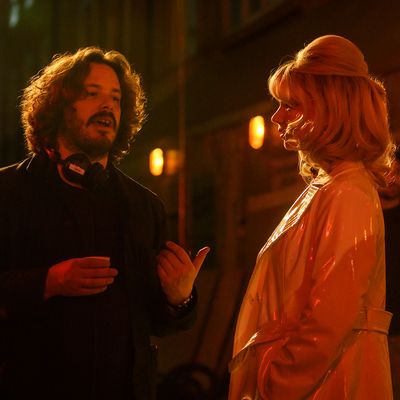
The dazzling, dizzying dream sequence materializes less than half an hour into writer-director Edgar Wright’s psychological thriller Last Night in Soho. The film’s heroine Eloise (Thomasin McKenzie of Leave No Trace and Jojo Rabbit fame) is a small-town girl who’s moved to central London to attend fashion college. As she drifts off to sleep in her apartment one night, she finds herself suddenly transported from the present day onto the bustling streets of a different version of her new city: specifically, London’s notoriously louche Soho district circa the Swinging ’60s. Inside a club, she catches her reflection in the mirror to discover she is no longer Eloise — she has morphed into Sandie, a Brigitte Bardot type (portrayed by Anya Taylor-Joy) whose mere presence (and a Pepto Bismol–pink chiffon dress) brings the club’s revelry to a standstill. Soon, Sandie/Eloise is being twirled across the dance floor by the wolfish music manager Jack (Doctor Who’s Matt Smith) in a bravura set piece of swooping camerawork, costuming, production design, and tag-team choreography.
Turns out that Eloise, a kind of amateur clairvoyant since her mother’s death from suicide, possesses some unexplainable connection to Sandie, who, as it also turns out, lived in the same bedsit flat. And as a consequence of this real-estate-induced, decade-spanning mind melding, the aspiring fashion designer must be a silent witness as the aspiring singer suffers through one crushing indignity after another. Until the turmoil of Sandie’s life — embodied by an army of ghoulish predators — comes to haunt Eloise even when she’s not asleep.
The seventh nondocumentary feature by Wright made its way to theaters on October 29, after having been delayed twice by distributor Focus Features over pandemic concerns. But to hear the British filmmaker tell it, Last Night in Soho’s journey to the screen begins in 2007, its script progressing in fits and starts even while Wright worked on other movies — The World’s End, Baby Driver, Scott Pilgrim vs. the World. Like several of his previous efforts, a carefully curated playlist of pop songs helped shape the story of what Wright originally envisioned as a “central London, female-led psychological thriller.” He hired a professional researcher to compile a dossier on ’60s culture, crime, and Soho history for additional realism. Wright met and first discussed casting Taylor-Joy (initially in the part of Eloise, not Sandie) after serving on the jury of the 2015 Sundance Film Festival, where she broke through in the art-house horror hit The Witch. It wasn’t until Wright was introduced to his eventual co-writer Krysty Wilson-Cairns (who earned a Best Original Screenplay Oscar nomination for the war epic 1917), though, that Soho gained traction as a project.
He sees his movie in the context of “a subgenre of dramas where a girl comes to London and has the temerity to try to make it in show business — and she will be roundly punished for the audacity of wanting to be a star. It started me thinking about the idea of a twin narrative. What if you did the modern version of this movie and a character is able to witness the ’60s version of the movie at the same time?”
The Four-Foot Pile of Research
For the uninitiated, the movie’s namesake neighborhood comprises a mere half–square mile of London’s most urban quadrant that is densely packed with bars, clubs, theaters, and cinemas. (As Wright points out, it is also the spiritual epicenter of the U.K. film industry.) In the 20th century, Soho was synonymous with sin: the locus of private drinking haunts and bordellos, where weird shit could happen to unsuspecting people.
To nail down the gritty verisimilitude of the area, Wright enlisted Lucy Pardee, an associate producer on the British sci-fi sensation Attack the Block and casting director for such films as American Honey and Rocks, to compile a “bible” of research material that eventually grew to be four feet tall. She interviewed locals who lived and worked in Soho in the Swinging ’60s and unearthed reams of documentary information regarding the sex industry and policing of central London from around that time. (Pardee’s research bled into broader subjects like sleep paralysis, ghost encounters, nightmares, and paranormal behavior, too.) Wright tacked up “beats” of information on a whiteboard in his production office, in a way he and Wilson-Cairns recall as “very serial killer–esque.”
“It looked like John Doe’s apartment from Se7en,” the director says.
Songs As Post-it Notes
As my colleague Nate Jones has pointed out, Last Night in Soho functions effectively as a “soundtrack movie,” i.e., a “movie that feels like a 90-minute mixtape, the cinematic equivalent of someone putting a pair of headphones on your head and saying, ‘You gotta listen to this.’” Among the deep-cut ’60s pop musical gems the director includes in Soho: the Kinks’ “Starstruck” (dismissed by a modern character as “granny shit”); “Anyone Who Had a Heart” and “Alfie,” performed by Cilla Black (a fictionalized version of whom appears in one scene); a cover of “Wade in the Water” by the Graham Bond Organisation; and Peter and Gordon’s wistful 1964 “A World Without Love.” At one point in the movie, Taylor-Joy takes the stage to perform an a cappella rendition of “Downtown,” by Petula Clark.
But long before the script-writing stage, the songs were integral to Wright’s process. “The songs have become synesthesia for the movie, where certain songs would trigger being able to see the scene in my head,” says Wright. “Some songs were almost like Post-it notes on the fridge saying, ‘Make this movie.’ You’d hear the song and you’d say, ‘I got to make this Soho thing.’”
Enter the Local Fixer
The director had the movie’s basic plot points worked out in 2016 when Wright’s Oscar-winning filmmaking friend Sam Mendes introduced him to Wilson-Cairns, who had been working in a Soho bar for five years while writing her debut movie screenplay Aether. Over dinner in the neighborhood, the Glasgow-born writer recalls Wright discussing his idea for a film about the “danger of romanticizing the good old days” that would be set in a “seedy or darker, different part of Soho.” “I was like, ‘Oh, I know that bit. That’s my bit of Soho,’” she says. “We were actually having dinner opposite the strip club I used to live above. Then we went out for drinks and I took him to this basement bar that’s a members bar. We went down there and there’s definitely a few criminals in there as well. A proper Soho haunt.” Nine months later, he called to ask her to write the movie with him.
The Toucan, the bar where Wilson-Cairns actually worked, is featured as Eloise’s part-time workplace — the backdrop to several unnerving run-ins between McKenzie’s character and a mysteriously intense barfly (played by Terence Stamp) who she suspects was responsible for Sandie’s undoing decades earlier. Wright drew particularly upon his co-writer’s experiences with sexism in the neighborhood. “I said to Krysty, ‘What is the worst, most horrific pickup line you’ve ever heard?’ And then that goes straight in the screenplay,” he says. (For the record, it is, “Excuse me, my dick just died. Do you mind if I bury it in your ass?”)
But both Wright and Wilson-Cairns are clear on the point: Wright’s decision to bring her into the story “was less about the fact that I was a woman and more about the fact I had experienced Soho,” says Wilson-Cairns. “Edgar’s a fantastic, empathetic writer and is not hemmed in by the idea that somehow men couldn’t write women. We collaborated.”
Mirror Tricks at the Café de Paris
Many of Last Night in Soho’s most visually dazzling sequences were shot inside a near-scale replica of London’s exclusive Café de Paris. The gilded nightclub is where Eloise first encounters Sandie, where the two trade places as dance partners with Matt Smith’s Jack in what has to be one of cinema’s most elaborate do-si-dos, and where Wright (in conjunction with cinematographer Chung-hoon Chung) used what he terms “old-school magic-trick stuff” to film the actresses as one another’s mirror image.
“It required a lot of rehearsal,” the director says. “A team effort. It’s not just production design. The camera operator has to be in the right place at the right time. The switching places isn’t motion control. That’s Thomasin and Anya running around the other side of the camera. What’s being shot is really there. The sequences with the mirror stuff is not green screen. There are tricks like double sets, mirrors that would slide back within the camera. There’s more happening in-camera than you’d think.” (Wright declined to further detail what went into filming the sequences, adding that in six months, viewers will be able to watch behind-the-scenes videos.)
Bring In the Extras
Wright grew up admiring lesser-known movies from the ’60s and ’70s featuring prominent central London locations: Séance on a Wet Afternoon, Deep End. But the practical aspects of filming his cinematic love letter to Soho in Soho proved much more of a challenge than he could have anticipated. Location managers began an extensive scouting process in December 2018, and after securing the necessary permits from the city and the agreement of local merchants, production began in the summer of 2019. For three weeks of night shoots, production designer Marcus Rowland oversaw trucking in a fleet of gleaming ’60s cars and platoons of background performers dressed in sharp period costume. Crews totally transformed Soho’s narrow streets with historically accurate set decoration — an enormous poster for the James Bond film Thunderball took over the real marquee for Empire Haymarket Cinema — then stripped it down in a matter of hours.
“There’s a certain part where you can’t really control it,” Wright says. “There’s a shot where Thomasin first comes into the ’60s and walks across the Haymarket. We had period cars and period extras. You cannot stop tourists in the center of London in the summer. You’re relying mostly on just people’s better nature to play ball and not walk through and ruin the shot. It became a war of attrition to keep the modern world at bay, the only way being to push them all out with tons of period extras and cars. But even doing that shot, the Westminster Council said, ‘Yes, you can shoot this between 10:30 and 2:30, but you have to keep one lane free for modern buses, fire engines, and ambulances.’”
McKenzie called Last Night in Soho the most complicated shoot of her career. “It was the most intense introduction to London anyone could have,” the 21-year-old actress said. “To be filming on the streets of Soho with drunk people walking in and out of the shot and refusing to get out of the way so we could get our shots before the sun came up — rushing to beat the sunrise.”
Wright prefers not to dwell on the tough stuff, but jokes that certain aspects of the production — such as trying to coordinate the line delivery of co-star Diana Rigg around the progression of neon lights flashing through an on-set window — gave him PTSD: “You find yourself in a complicated scene, grumbling in a corner. You say, ‘Whose idea was it to do this?’ ‘Ugh. It was your idea, Edgar. Why did you do this to yourself?’”



